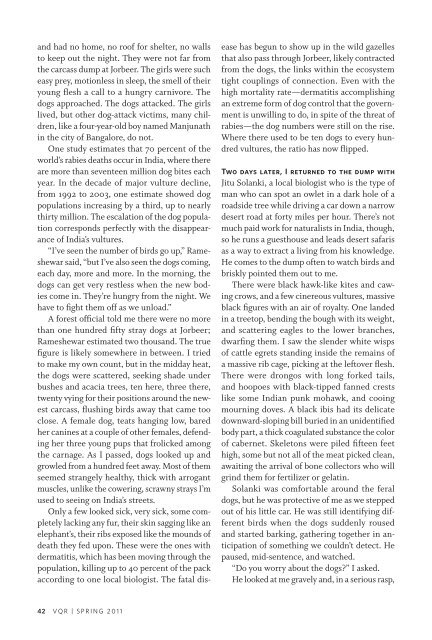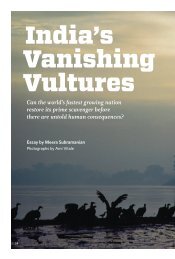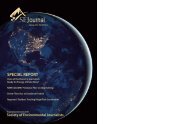Create successful ePaper yourself
Turn your PDF publications into a flip-book with our unique Google optimized e-Paper software.
and had no home, no roof for shelter, no walls<br />
to keep out the night. They were not far from<br />
the carcass dump at Jorbeer. The girls were such<br />
easy prey, motionless in sleep, the smell of their<br />
young flesh a call to a hungry carnivore. The<br />
dogs approached. The dogs attacked. The girls<br />
lived, but other dog-attack victims, many children,<br />
like a four-year-old boy named Manjunath<br />
in the city of Bangalore, do not.<br />
One study estimates that 70 percent of the<br />
world’s rabies deaths occur in India, where there<br />
are more than seventeen million dog bites each<br />
year. In the decade of major vulture decline,<br />
from 1992 to 2003, one estimate showed dog<br />
populations increasing by a third, up to nearly<br />
thirty million. The escalation of the dog population<br />
corresponds perfectly with the disappearance<br />
of <strong>India’s</strong> vultures.<br />
“I’ve seen the number of birds go up,” Rameshewar<br />
said, “but I’ve also seen the dogs coming,<br />
each day, more and more. In the morning, the<br />
dogs can get very restless when the new bodies<br />
come in. They’re hungry from the night. We<br />
have to fight them off as we unload.”<br />
A forest official told me there were no more<br />
than one hundred fifty stray dogs at Jorbeer;<br />
Rameshewar estimated two thousand. The true<br />
figure is likely somewhere in between. I tried<br />
to make my own count, but in the midday heat,<br />
the dogs were scattered, seeking shade under<br />
bushes and acacia trees, ten here, three there,<br />
twenty vying for their positions around the newest<br />
carcass, flushing birds away that came too<br />
close. A female dog, teats hanging low, bared<br />
her canines at a couple of other females, defending<br />
her three young pups that frolicked among<br />
the carnage. As I passed, dogs looked up and<br />
growled from a hundred feet away. Most of them<br />
seemed strangely healthy, thick with arrogant<br />
muscles, unlike the cowering, scrawny strays I’m<br />
used to seeing on <strong>India’s</strong> streets.<br />
Only a few looked sick, very sick, some completely<br />
lacking any fur, their skin sagging like an<br />
elephant’s, their ribs exposed like the mounds of<br />
death they fed upon. These were the ones with<br />
dermatitis, which has been moving through the<br />
population, killing up to 40 percent of the pack<br />
according to one local biologist. The fatal dis-<br />
42 VQr | SPrIng 2011<br />
ease has begun to show up in the wild gazelles<br />
that also pass through Jorbeer, likely contracted<br />
from the dogs, the links within the ecosystem<br />
tight couplings of connection. Even with the<br />
high mortality rate—dermatitis accomplishing<br />
an extreme form of dog control that the government<br />
is unwilling to do, in spite of the threat of<br />
rabies—the dog numbers were still on the rise.<br />
Where there used to be ten dogs to every hundred<br />
vultures, the ratio has now flipped.<br />
Two days later, I returned to the dump with<br />
Jitu Solanki, a local biologist who is the type of<br />
man who can spot an owlet in a dark hole of a<br />
roadside tree while driving a car down a narrow<br />
desert road at forty miles per hour. There’s not<br />
much paid work for naturalists in India, though,<br />
so he runs a guesthouse and leads desert safaris<br />
as a way to extract a living from his knowledge.<br />
He comes to the dump often to watch birds and<br />
briskly pointed them out to me.<br />
There were black hawk-like kites and cawing<br />
crows, and a few cinereous vultures, massive<br />
black figures with an air of royalty. One landed<br />
in a treetop, bending the bough with its weight,<br />
and scattering eagles to the lower branches,<br />
dwarfing them. I saw the slender white wisps<br />
of cattle egrets standing inside the remains of<br />
a massive rib cage, picking at the leftover flesh.<br />
There were drongos with long forked tails,<br />
and hoopoes with black-tipped fanned crests<br />
like some Indian punk mohawk, and cooing<br />
mourning doves. A black ibis had its delicate<br />
downward-sloping bill buried in an unidentified<br />
body part, a thick coagulated substance the color<br />
of cabernet. Skeletons were piled fifteen feet<br />
high, some but not all of the meat picked clean,<br />
awaiting the arrival of bone collectors who will<br />
grind them for fertilizer or gelatin.<br />
Solanki was comfortable around the feral<br />
dogs, but he was protective of me as we stepped<br />
out of his little car. He was still identifying different<br />
birds when the dogs suddenly roused<br />
and started barking, gathering together in anticipation<br />
of something we couldn’t detect. He<br />
paused, mid-sentence, and watched.<br />
“Do you worry about the dogs?” I asked.<br />
He looked at me gravely and, in a serious rasp,












